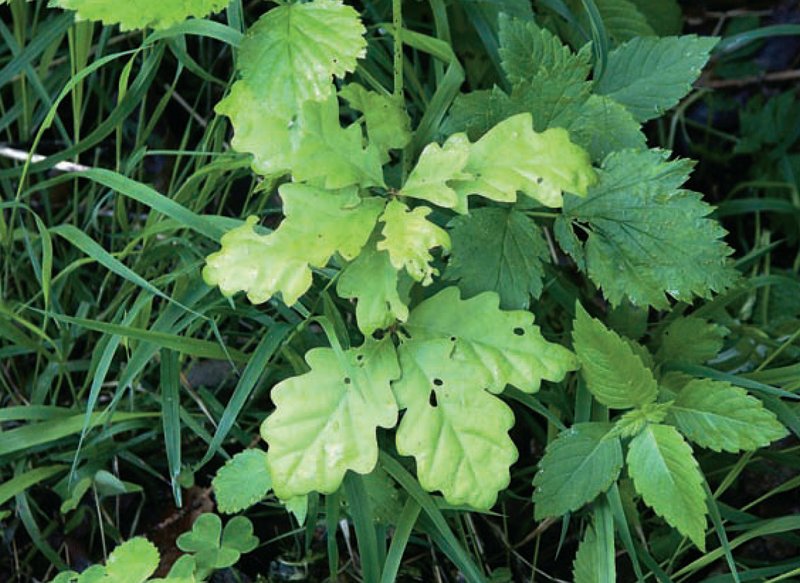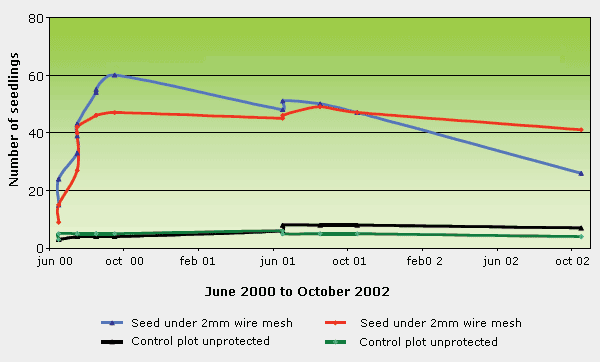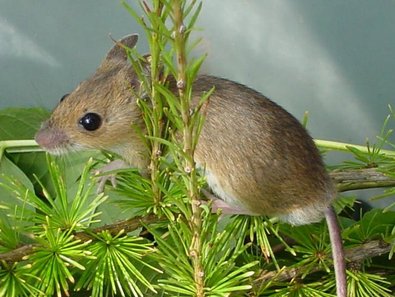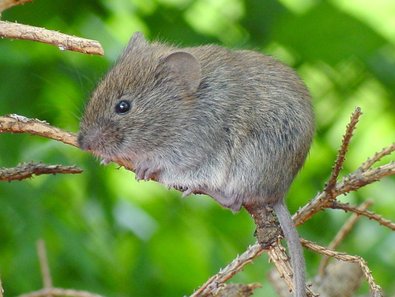In a pilot trial study on natural oak regeneration the effect of deer and mice on the growth of oaks in a regeneration area was studied. The mortality rate of planted acorns during the germination and seedling phase was also studied. The results of this case study illustrate the interaction of many important factors.
The experiment was laid out in the winter of 1998/1999, in a 40 acre regeneration area in “Churholz” near Waltenschwil in the Canton of Aargau. This is a 7d type of forest community, a typical woodruff/beech forest containing woodrush, situated at 460 m above sea level. At the edges of the felling area individual oaks had produced a full mast in 1998. In the spring of 1999 there was therefore an abundance of acorns and oak seedlings around the mother trees.

Fig. 1: A naturally regenerated English oak with accompanying ground flora. Photo: Ulrich Wasem (WSL)
The trial layout order
In the regeneration area acorns were planted in two wooden frames of 100 cm x 100 cm which were set 20 cm into the ground and covered with wire to keep out mice, birds, squirrels and slugs. As a control and comparison area two unprotected plots were laid out. The 100 sown acorns were from stratified, high quality, slightly forced seed, from which a high level of germination was expected.
Parallel to this in April 1999 three pairs of control plots were established each with a fenced plot of 5 x 5 m and a non-fenced plot 10 m distant. Two further pairs of plots had to be scrapped after the storm “Lothar”. From 2000 to 2002, in both the fenced and the non-fenced control plots, the planted acorns were controlled several times a year. In the spring of 1999 and the autumn of 2004 tree and herbaceous regeneration and the accompanying ground flora was recorded in both plots. The types of vegetation were classed and counted according to species and height. At the beginning of the experiment the game count was 12 to 15 deer per 100 ha. In spring 2004 15 to 18 animals were counted.
Mice reduce sown oaks
In the wooden frames 60%, respectively 47% of the acorns germinated. In the neighbouring unprotected control plots it was only 4%, respectively 5 % (Fig. 2).

Fig. 2. The germination progress of the sown acorns from June 2000 to October 2002.
A large part of the sown acorns disappeared from the control plots in the first few days after sowing. The acorns were covered with leaves and litter and were probably collected by mice. Using live traps it was possible to determine that the small mammals responsible were yellow necked field mice and bank voles.
The germinating acorns and seedlings in the two unprotected check plots were always freely accessible to roe deer. After 6 years the growth form of the 15 to 20 cm high oaks bore the stamp of continuous terminal shoot browsing. The seedlings under the wire reached a height of 15 to 20 cm after 2 years. After the protective cover was removed their growth stagnated due to browsing. Only the future will show whether the young oaks will be able to outgrow animal damage.
More oaks survived outside of the fence
At the start of the experiment in 1999 126 (7, 74, 45) oaks were counted within the fenced off plots and 152 (10, 57, 85) in the control plots. Within five years the number of oaks in the fenced off plots had been reduced by 90% to 13 surviving specimens and in the non-fenced areas by 72% to 42 surviving oaks (2, 21, 19). Therefore, considerably more oaks survived in the control plots than in the fenced plots. The surviving oaks within the fenced plots had however grown taller than those in the control plots. Here the oaks had reached a height of between 25 and 100 cm (on average 60 cm) by 2004. The oaks within the fenced plots had reached a height of 70 to 220 cm (on average 1, 25 cm) and were therefore taller.
Too many blackberry briars for young oaks
From the spring of 1999 to the autumn of 2004 the ground flora in the fenced plots and in the control plots developed as follows:
- In the summer of 1999 the ground was covered with sparse grasses, hemp nettles and occasional blackberry briars. The remaining oak and beech stocks had once again sprouted. The oak coppice shoots were a source of food for roe deer. After three years the vitality of the old stocks had been greatly reduced and in the meantime no more coppice shoots have reappeared.
- Within three to four years blackberries totally overgrew the six areas (blackberry covering density 100%). Using the mesh of the fence they grew much higher within the fenced plots, with their tendrils reaching a height of 3 to 4 m.
- A similar effect was observed in the windfall areas, where the storm wood was left on the ground (Angst et. al. 2005). This smothering effect caused by the accompanying vegetation within the fenced off plots played an important role in the high mortality rate of the oak trees. Browsing by roe deer on blackberry, birch, willow and alder in the non-fenced control plots led to less dense and less high vegetation than within the fenced plots.

Fig. 5: Development of ground flora in the studied clearing after felling 1998/2004. Photos: Oswald Odermatt (WSL)
Rival vegetation: more important than mice or deer?
This small scale case study provides important information about the success or lack of it of natural regeneration of oaks. Assuming that 300,000 acorns/ha are lying on the ground after a full mast (Krahl-Urban 1959) and assuming that 49 % - as in the above trial – are eaten by mice, that still leaves 147,000 acorns/ha. Mice alone, in spite of their appetite for acorns, cannot prevent oak regeneration.
Neither have deer, up to present, prevented the survival of oaks in “Churholz”. It is still unclear whether this will be the case over a long period of time. Deer in the above study even tripled the chances of survival of the oaks by keeping the rival vegetation down. Within the fenced plots a thick covering of blackberries developed which killed off many oaks. The oaks within the fence were 70 – 220 cm high and in the control plots 25 – 100 cm. If the amount of browsing remains constant then several unprotected oaks may survive and grow tall enough to escape browsing.
The pros and cons of fencing versus individual protection should therefore take rival vegetation into consideration: individual protection should encourage deer to browse on the rival vegetation. That planted oak trees cannot grow without game protection even after wide spread windfall when there is plenty of other vegetation available for browsing was proved in other areas after the storm “Lothar” (Koch + Brang 2005). On top of this there can also be damage done due to fraying. This did not occur in the above case study, but the installation of fraying protection would be advisable.
Translation: Dawn Meister (Affoltern a. A.)


